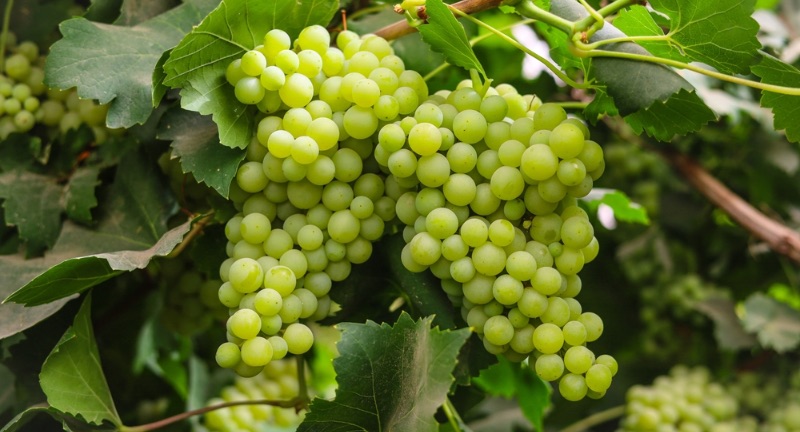EXPLORE
Why Grapes Are One Of The Best Fruits
Published
2 months agoon

Shutterstock
Grapes are one of the most popular fruits in the whole world. These juicy fruits have a long-standing significance in many parts of the world and are used in many different dishes. Going beyond their flavor, grapes are packed with health benefits and serve as the main ingredient in products like wine and raisins. This article will show you the most interesting facts about grapes, showing just how important they are.
Grapes are a fruit of the vine, scientifically known as *Vitis vinifera*

Shutterstock
Grapes are the fruit of the grapevine, a perennial plant in the family Vitaceae. They have been cultivated for thousands of years, primarily for their use in wine production. The scientific name *Vitis vinifera* refers to the most commonly cultivated species. Grapevines are widely grown in temperate climates around the world, thriving in regions like California, France, and Italy.
There are over 8,000 grape varieties

Shutterstock
There are more than 8,000 different varieties of grapes worldwide, each with its unique characteristics. These varieties include different colors, shapes, sizes, and flavors. Some are primarily used for table consumption, while others are used for making wine or raisins. The diversity of grape varieties contributes to the wide range of products that can be made from them.
Grapes are grown on every continent except Antarctica

Shutterstock
Grapes are cultivated in nearly every corner of the world, from North America to Europe and beyond. They are grown in temperate climates with warm summers, such as the Mediterranean, South America, and Australia. In fact, grapes are one of the most widely grown fruit crops globally. The only continent without commercial grape production is Antarctica, due to its extreme climate.
Grapes can be red, green, or black

Shutterstock
Grapes come in a variety of colors, including red, green, and black, each with distinct qualities. Red grapes often have a sweeter flavor, while green grapes are typically more tart. Black grapes tend to be juicier and are usually used in wine production. The color of grapes is determined by the specific variety and the amount of pigments in the skin.
The grapevine is a woody, perennial plant

Shutterstock
The grapevine is a woody plant that can live for many years, often producing fruit for decades. It is a perennial, meaning it continues to grow year after year, with new growth emerging each season. Grapevines are typically pruned to optimize fruit production. Their ability to survive and thrive year after year makes them a valuable crop for growers.
Grapes are used to make wine, raisins, and grape juice

Shutterstock
Grapes are incredibly versatile and are used to produce a variety of products. The most famous product is wine, made through the fermentation of crushed grapes. Grapes are also dried to produce raisins, a popular snack and baking ingredient. Additionally, grape juice is made by extracting the juice from fresh grapes, offering a sweet and nutritious beverage.
The average grape cluster contains about 75 to 100 individual grapes

Shutterstock
A typical grape cluster, also known as a bunch, contains approximately 75 to 100 grapes. The size of the cluster can vary based on the grape variety and the growing conditions. Some varieties may have smaller clusters, while others produce larger, more densely packed bunches. Each grape in the cluster is connected by a stem that can be harvested and processed together.
The oldest known cultivated grapevines date back over 6,000 years

Shutterstock
Grapes have been cultivated for thousands of years, with the oldest known grapevines being over 6,000 years old. Evidence suggests that ancient civilizations in the Middle East were among the first to domesticate and cultivate grapes for wine production. These early grapevines were likely selected for their ability to produce wine, a significant part of religious and social rituals. The long history of grape cultivation highlights the importance of grapes in human culture.
Grapes are rich in antioxidants, including resveratrol

Shutterstock
Grapes are a rich source of antioxidants, compounds that help protect the body from harmful free radicals. One of the most well-known antioxidants in grapes is resveratrol, which is found in the skins of red and black grapes. Resveratrol has been studied for its potential health benefits, including promoting heart health. The antioxidants in grapes also contribute to their vibrant color and help protect the fruit from damage during growth.
The skin of grapes contains a substance called anthocyanin

Shutterstock
The skin of grapes contains anthocyanin, a type of flavonoid responsible for the color in red and black varieties. Anthocyanins are powerful antioxidants that help protect cells from damage. They also contribute to the health benefits of grapes, such as reducing inflammation and supporting cardiovascular health. The concentration of anthocyanin is higher in darker-colored grapes, making them particularly rich in these beneficial compounds.
Grapes are naturally sweet but also contain acids like tartaric acid

Shutterstock
Grapes have a naturally sweet flavor due to their high sugar content. However, they also contain various acids that contribute to their tart taste, such as tartaric acid. This balance between sweetness and acidity makes grapes a versatile fruit for both eating fresh and processing into products like wine. Tartaric acid is particularly important in wine production, where it contributes to the flavor and preservation of the wine.
Seedless grapes were first discovered in the early 20th century

Shutterstock
Seedless grapes were a significant innovation in grape cultivation, first discovered in the early 20th century. These grapes are the result of natural mutations and selective breeding, making them more convenient for consumers. Seedless grapes are particularly popular for snacking and are often preferred by those who dislike dealing with seeds. Their development has led to an increase in the popularity of grapes for direct consumption, as well as for products like raisins and wine.
Grapes are one of the most commonly cultivated fruits globally

Shutterstock
Grapes are one of the most widely cultivated fruits in the world, grown across many continents and climates. They are particularly abundant in Mediterranean countries, as well as regions in North America and South America. The global popularity of grapes can be attributed to their versatility in food products and beverages, such as wine and juice. Grapes are a key agricultural crop that supports economies and communities worldwide.
They are often grown in temperate climates with dry summers

Shutterstock
Grapes thrive in temperate climates, which are characterized by mild winters and warm, dry summers. These conditions are ideal for the growth of grapevines, as they require plenty of sunlight to produce sugar-rich fruit. Regions such as California, parts of South America, and Southern Europe are known for their perfect grape-growing climates. The warm, dry summers help prevent fungal diseases, which can harm grapevines.
Grapevines can live for up to 30 to 50 years

Shutterstock
Grapevines are long-living plants that can endure for 30 to 50 years or even longer with proper care. Over the years, a well-maintained grapevine can continue producing fruit, though its yield may decline as it ages. The longevity of grapevines makes them a valuable investment for growers, as they can provide a reliable harvest for many decades. Older vines are often prized for producing high-quality grapes, particularly in the wine industry.
Grapes are typically harvested in late summer to early fall

Shutterstock
The harvest season for grapes typically falls between late summer and early fall, depending on the climate and grape variety. Grapes are harvested when they reach peak ripeness, with their sugar content at its highest. In regions with warmer climates, such as California, the harvest may occur as early as August. In cooler climates, grapes may not be harvested until October or later.
A bunch of grapes is also known as a “cluster”

Shutterstock
A group of grapes that grow together on the vine is referred to as a “cluster.” Clusters can vary in size, shape, and density depending on the grape variety. Clusters of grapes are typically harvested together, with the entire bunch being cut from the vine at once. In winemaking, the quality and composition of the cluster play an important role in the final product.
The largest grapevine in the world is over 200 years old and located in the UK

Shutterstock
The world’s largest grapevine, located in the UK, is over 200 years old. This vine has grown to an impressive size, covering a vast area with its sprawling branches. Despite its age, the vine continues to produce fruit each year, making it a remarkable example of longevity in grapevine cultivation. The vine is a popular tourist attraction, drawing visitors from around the world to marvel at its size and age.
Concord grapes are known for their distinct purple color and strong flavor

Shutterstock
Concord grapes are a popular variety of dark purple grapes, known for their sweet, bold flavor. These grapes are often used in making juices, jams, and jellies, as well as in winemaking. Their rich purple color is a key characteristic, and they have a distinctive taste that is often described as “grapey.” Concord grapes are typically grown in North America, where they are a favorite for their strong, fruity taste.
Grapes have been associated with religious rituals in various cultures

Shutterstock
Grapes have long been associated with religious and spiritual rituals in many cultures. In ancient Egypt, grapes were used in offerings to the gods, symbolizing abundance and fertility. Similarly, in Greek and Roman cultures, grapes were sacred to Dionysus, the god of wine. The connection between grapes and religious symbolism continues in modern rituals, especially during celebrations involving wine, such as the Christian sacrament of communion.
The seeds of grapes are a source of grape seed oil

Shutterstock
The seeds of grapes are a valuable byproduct that can be used to make grape seed oil. This oil is known for its high levels of antioxidants, particularly vitamin E, and its ability to promote skin health. Grape seed oil is commonly used in cosmetic products, such as moisturizers, serums, and hair care treatments. It is also used in cooking, where it is valued for its light flavor and high smoke point.
Grapes contain a significant amount of water, often more than 80%

Shutterstock
Grapes are made up of more than 80% water, making them a hydrating fruit. This high water content helps keep the fruit refreshing and juicy. The water in grapes also helps preserve the fruit’s texture and flavor during storage. Additionally, the water content in grapes plays a role in their ability to be processed into juice and wine.
The grapevine is capable of self-pollination

Shutterstock
Grapevines have the ability to self-pollinate, meaning they do not require another plant for fertilization. The flowers of the grapevine contain both male and female reproductive organs, allowing the plant to produce fruit on its own. Self-pollination is especially beneficial in regions with limited access to other grapevines for cross-pollination. While cross-pollination can improve genetic diversity, self-pollinating grapevines are still highly productive.
Grapes are often used as a symbol of abundance and fertility

Shutterstock
Throughout history, grapes have been used as symbols of abundance, fertility, and prosperity. In many cultures, they are seen as a gift of nature that represents wealth and good fortune. In art and literature, grapes are often depicted in scenes of harvest and celebration. The abundance of grapes and their versatility in food and drink make them an enduring symbol of the earth’s generosity.
They have a relatively short shelf life and are sensitive to temperature changes

Shutterstock
Grapes are known for having a relatively short shelf life compared to other fruits. They are highly perishable and can spoil quickly if not stored properly. Grapes should be kept cool and dry, as they are sensitive to both heat and moisture, which can cause them to rot. Their delicate nature requires careful handling during transport and storage to maintain their freshness.
Grapes have been found in Egyptian tombs, indicating their long history

Shutterstock
Grapes have been found in ancient Egyptian tombs, a testament to their long history and cultural significance. Archaeological evidence suggests that grapes were valued by ancient civilizations, particularly in Egypt, where they were often included in burial offerings. Grapes were seen as a symbol of life and regeneration, which made them important in rituals related to death and the afterlife. This historical connection highlights the longstanding role of grapes in human culture.
The fruit is high in potassium and vitamin C

Shutterstock
Grapes are an excellent source of potassium, an essential mineral that helps regulate blood pressure and muscle function. They are also rich in vitamin C, an important antioxidant that supports the immune system and skin health. These nutrients contribute to grapes’ health benefits, making them a nutritious addition to a balanced diet. Additionally, the antioxidants found in grapes support overall health and wellness.
The process of making wine from grapes is called fermentation

Shutterstock
The process of making wine from grapes involves fermentation, during which sugars in the grapes are converted into alcohol. Yeast is used to ferment the grape juice, producing not only alcohol but also complex flavors. Fermentation is a delicate process that can significantly affect the taste and quality of the wine. This process has been refined over thousands of years and remains a cornerstone of the wine industry.
Conclusion

Shutterstock
Grapes have a long history of versatility and popularity that keeps their legacy going strong. They pair perfectly with snacks and are used to make the finest wine. Grapes are the perfect blend of nature and humanity. Whether you are eating them alone or as part of a dish, grapes will always be one of the best snack foods.
Related Topics:

More From Lifestylogy
-


25 Ways To Incorporate More Magnesium Into Your Diet
-


Fabulous Fruit: 30 Of Tomatoes Biggest Historical Accomplishments
-


30 Highest Paid Netflix Actors and Actresses
-


20 Vitamins That Make The Most Impact On Your Health
-


Hardwood Is The Best: Here’s Why
-


The Long History Of Cheese
-


25 Global Food Trends That Will Continue Into 2025
-


25 Foods That Are High In Protein But Low In…
-


Why You Should Only Burn One Type Of Candle